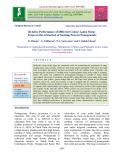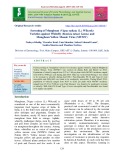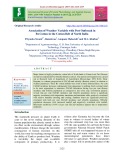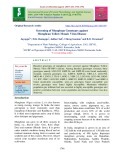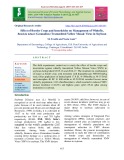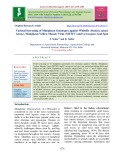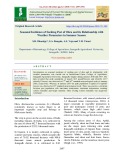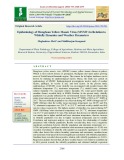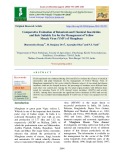
Incidence of whiteflies
-
During the investigation sucking pest viz; white fly and jassid were appeared in 33 standard meteorological week and maximum population of whitefly (0.60 per plant) and jassid (0.40 per plant) was recorded in 37th SMW. Correlation with sucking pest (whitefly and jassid) population and meteorological parameters was found positive non significant association with evening relative humidity and minimum temperature but negative correlation with maximum temperature, morning relative humidity and rainfall.
 8p
8p  caygaocaolon11
caygaocaolon11
 21-04-2021
21-04-2021
 11
11
 1
1
 Download
Download
-
This infection is observed during October month in these volunteer plants continuously for the two years (2019 & 2020). The population of the vector whitefly is also observed in the Malvastrum coromandelianum and Sida acuta, this may facilitate for the transmission of the virus and Eventhough, with vector population, these species alone being observed with infection with this specific virus remaining weeds are not infected hence this may be host specific. Hence Malvastrum coromandelianum is documented as highly susceptible to this specific virus and needs research on infecting to the crops.
 4p
4p  caygaocaolon11
caygaocaolon11
 21-04-2021
21-04-2021
 10
10
 1
1
 Download
Download
-
Different colour sticky traps are commonly used for monitoring the population of many sucking pests such as thrips, whiteflies, leaf miner adults and aphids. They have also been used to monitor the natural enemies associated with the sucking pests. Presently, the monitoring the incidence of sucking pests in pomegranate using sticky traps is wanting. Hence, the study was conducted in pomegranate planting at orchard of Tamil Nadu Agricultural University, Coimbatore during 2016, using different colour laden sticky traps like yellow, pale yellow, green, orange and red.
 8p
8p  nguaconbaynhay10
nguaconbaynhay10
 22-01-2021
22-01-2021
 10
10
 2
2
 Download
Download
-
Studies in this regard and epidemiological aspects of MYMV are scanty in the North Eastern Karnataka region. Hence the studies were conducted to know the influence of weather parameters on whitefly population and MYMV incidence.
 11p
11p  gaocaolon9
gaocaolon9
 22-12-2020
22-12-2020
 13
13
 1
1
 Download
Download
-
Survey was conducted in major pomegranate growing area of Tharad, Deodar and Bhabhar talukas of Banaskantha district in Gujarat during mrig bahar season by using of multistage ramdom methods. Population of anar butterfly, fruit suckin moth, thrips, whitefly and aphid was observed during the period of study.
 4p
4p  trinhthamhodang9
trinhthamhodang9
 16-12-2020
16-12-2020
 17
17
 2
2
 Download
Download
-
Field screening of 5 mungbean varieties for resistance against whitefly, induced Mungbean Yellow Mosaic Virus (MYMV) was carried out during Rabi and Kharif on 2014. Population of whitefly ranged from 3.22 to 7.69 per plant while MYMV incidence ranged from 6.00 to 39.00 per cent during Zaid 2014. Only one variety Pant Moong-1 was found to be resistant to whitefly during Zaid 2014.
 4p
4p  nguathienthan8
nguathienthan8
 20-10-2020
20-10-2020
 16
16
 2
2
 Download
Download
-
Major threat to highly productive cotton belt of North India is Cotton Leaf Curl Disease exclusively transmitted by whitefly (Bemisia tabaci). The present investigation was carried out at Research farm of department of Agricultural Meteorology, CCS HAU, Hisar Haryana, to evaluate progression of CLCuD and whitefly (Bemisia tabaci) in relation to weather parameters. Three Bt -cotton hybrids were sown at three different dates. Per cent CLCuD incidence increases continuously from appearance to picking.
 13p
13p  trinhthamhodang1215
trinhthamhodang1215
 23-09-2020
23-09-2020
 14
14
 1
1
 Download
Download
-
This is because the incidence and spread of a single virus disease may be dependent on several vectors which have complicated ecologies themselves (Bos, 1986). Whitefly (Bamasia tabaci) transmitted cotton leaf curl virus disease was the major problem in cotton cultivation (Sharma et al., 2006). However, weather has a very crucial role in CLCuD spread and development and also affects its vector whitefly’s ecology.
 8p
8p  cothumenhmong7
cothumenhmong7
 09-09-2020
09-09-2020
 13
13
 1
1
 Download
Download
-
Hundred genotypes of mungbean were screened against Mungbean Yellow Mosaic Virus (MYMV) disease. Among hundred genotypes screened, three genotypes namely LGG-593, KMP-24, and KMP-40 were found moderately resistant, nineteen genotypes viz., KMP-4, KMP-22, VBN-2-3, LGG-594, MGG-40-1, JNG-13, TK-6-1, BGG-1, VBN-2-3, LGG-410, LGG-410, KKM3-1, ICC-12947, LGG-592, KMP-1, KMP-22, KMP-23, KMP-17 and KMP-4 found moderately susceptible, sixty-six genotypes found susceptible and twelve genotypes were found highly susceptible.
 7p
7p  cothumenhmong7
cothumenhmong7
 08-09-2020
08-09-2020
 13
13
 1
1
 Download
Download
-
The field experiments carried out to study the effect of border crops and insecticides against whitefly transmitted Yellow Mosaic Virus (YMV) in soybean during kharif 2015-16 and 2016-17. The treatment in combination of maize as border crop, seed treatment with thiamethoxam 30FS@5ml/kg seed, foliar application of imidacloprid 17.8 SL @ 500ml/ha at 30-35 DAS and triazophos 40 EC @ 800 ml/ha at 45-50 DAS recorded lowest mean whitefly population (1.02 whiteflies/plant), which resulted in reduced YMV disease incidence (14.63%) and highest grain yield (19.42 q/ha) among treatments in soybean.
 5p
5p  trinhthamhodang7
trinhthamhodang7
 31-08-2020
31-08-2020
 12
12
 2
2
 Download
Download
-
High phenotypic coefficient of variation and genotypic coefficient of variation were observed for percent potato apical leaf-curl disease (PALCD) incidence at 40, 60 and 80 DAP, whitefly population at 20 and 30 DAE and phenols.
 17p
17p  trinhthamhodang7
trinhthamhodang7
 31-08-2020
31-08-2020
 13
13
 2
2
 Download
Download
-
Population dynamics of sucking pests of sesame viz. thrips, whitefly, leaf hoppers and aphids were studied. Correlation between the pest population and weather parameters was analyzed and regression equations were developed. Incidence of aphids, leaf hoppers and thrips on sesame crop during kharif season has started on 25th SMW.
 11p
11p  nguaconbaynhay7
nguaconbaynhay7
 15-08-2020
15-08-2020
 17
17
 1
1
 Download
Download
-
Field screening of 52 mungbean genotypes for resistance against whitefly, Mungbean Yellow Mosaic Virus (MYMV) and Cercospora leaf spot was carried out during Rabi and Kharif on 2015-2016. Population of whitefly ranged from 2.5 to 7.7 no./3 leaves while MYMV incidence ranged from 13.7 to 66.2 per cent. Two cultures viz., VBN 2 and CO 8 recorded low mean population of whitefly 2.5 and 2.7 no/3 leaves, respectively followed by VBN-3 (2.9 no. /3 leaves), PDM-54 (3.1 no. /3 leaves) and GM 4 (3.5 no. /3 leaves) whereas RM 612 recorded high mean population of whitefly (7.7 no.
 8p
8p  chauchaungayxua6
chauchaungayxua6
 26-06-2020
26-06-2020
 16
16
 2
2
 Download
Download
-
Experiment under field condition was conducted to test the effect of insecticides against whiteflies checking the incidence of yellow vein mosaic virus (YVMV) on okra at Indian Agriculture Research Institute, Regional Station, College of Agriculture, Pune. The present study conducted in randomized block design with eight treatments. The seven insecticides were evaluated against whiteflies checking the yellow vein mosaic virus (YVMV) incidence .The observations on whiteflies mortality and incidence of YVMV incidence recorded at 3, 7 and 14 days after each spray.
 5p
5p  nguaconbaynhay6
nguaconbaynhay6
 24-06-2020
24-06-2020
 9
9
 1
1
 Download
Download
-
Among sixteen mung bean genotypes evaluated against whitefly and MYMV disease incidence, four genotypes viz., SMP17-17, SMP17-18, SMP17-24 and SMP17-25 recorded less number of whitefly (1.62 to 3.2 /trifoliate leaf) with disease incidence of 1 to 10 per cent and were categorized as resistant (R) with disease rating 3, four genotypes viz., SMP17-19, SMP17-20, SMP17-21 and SMP17-29 exhibited 11-20 per cent MYMV disease incidence having disease rating scale 5 and categorized as moderately resistant (MR) and remaining eight genotypes viz.
 9p
9p  nguaconbaynhay6
nguaconbaynhay6
 23-06-2020
23-06-2020
 12
12
 1
1
 Download
Download
-
Investigation on seasonal incidence of sucking pest of okra and its relationship with weather parameters was carried out at Instructional Farm, College of Agriculture, Junagadh Agricultural University, Junagadh, Gujarat during summer 2016 and 2017. The data revealed that peak population of jassid (16.1 jassid/3leaves) and whitefly (15.7 whitefly/3 leaves) was observed at 17th and 16th standard meteorological week of summer 2016, respectively. Whereas, in summer 2017 the peak population of aphid (17.8 aphid/3 leaves) was observed at 16th standard meteorological week.
 8p
8p  gaocaolon5
gaocaolon5
 14-06-2020
14-06-2020
 11
11
 1
1
 Download
Download
-
Seasonal incidence of different sucking pests of chilli viz., thrips (Scirtothrips dorsalis Hood), mites (Polyphagotarsonemus latus Banks), Aphid (Aphis gossypii Glov.), Whitefly (Bemesia tabaci Genn.) and Jassids (Amrsca bigutula bigutula) and natural enemies like Coccinellids and spiders were worked out in the present study during 2016 at District Seed Farm (AB Block) of Bidhan Chandra Krishi Viswavidyalaya located at Kalyani, Nadia, West Bengal. Peak population of thrips was recorded to be in 18th standard week i.e. 12.
 13p
13p  angicungduoc5
angicungduoc5
 12-06-2020
12-06-2020
 20
20
 0
0
 Download
Download
-
Mungbean yellow mosaic virus (MYMV) causes yellow mosaic disease in pulses. Which is most serious disease in greengram, blackgram and many pulses growing areas of North Eastern Karnataka region. The reasons for its higher incidence can be known by studying its epidemiological factors.
 8p
8p  trinhthamhodang1213
trinhthamhodang1213
 02-06-2020
02-06-2020
 9
9
 1
1
 Download
Download
-
Field experiment was conducted during 2011 and 2012 to evaluate the efficacy of chemical insecticides and plant botanicals for the management of Yellow Mosaic Virus of Mungbean transmitted by the vector whitefly (Bemisia tabaci). It was noted that disease incidence could not be escaped however, the percentage of incidence were different from each other over control plot. Among the five plant origin products with different doses tested for spraying, Neem @ 0.2% showed lowest incidence (10.49%) and severity (9.58%). Among three insecticides the significant lowest incidence (8.
 8p
8p  trinhthamhodang1213
trinhthamhodang1213
 02-06-2020
02-06-2020
 22
22
 1
1
 Download
Download
-
The incidence of major pests of pongamia in relation to weather parameters was observed during 2016-17 at Zonal Agricultural Research Station, UAS, GKVK, Bengaluru. The important pests recorded on pongamia were blotch miner (Acrocercops anthrauris Fabricius), spiralling whitefly Aleurodiccus disperses (Russel), and the eriophyid mite, Aceria pongamiae Channabasavanna causing leaf galls.
 14p
14p  cothumenhmong5
cothumenhmong5
 17-05-2020
17-05-2020
 7
7
 1
1
 Download
Download
CHỦ ĐỀ BẠN MUỐN TÌM










